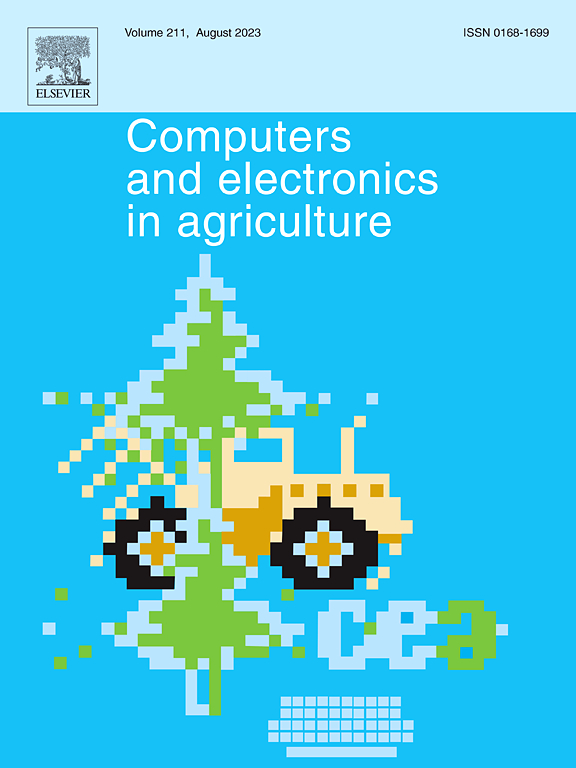In-field blueberry fruit phenotyping with a MARS-PhenoBot and customized BerryNet
IF 8.9
1区 农林科学
Q1 AGRICULTURE, MULTIDISCIPLINARY
引用次数: 0
Abstract
Accurate blueberry fruit phenotyping, including yield, fruit maturity, and cluster compactness, is crucial for optimizing crop breeding and management practices. Recent advances in machine vision and deep learning have shown promising potential to automate phenotyping and replace manual sampling. This paper presented a robotic blueberry phenotyping system, called MARS-Phenobot, that collects data in the field and measures fruit-related phenotypic traits such as fruit number, maturity, and compactness. Our workflow comprised four components: a robotic multi-view imaging system for high-throughput data collection, a vision foundation model (Segment Anything Model, SAM) for mask-free data labeling, a customized BerryNet deep learning model for detecting blueberry clusters and segmenting fruit, as well as a post-processing module for estimating yield, maturity, and cluster compactness. A customized deep learning model, BerryNet, was designed for detecting fruit clusters and segmenting individual berries by integrating low-level pyramid features, rapid partial convolutional blocks, and BiFPN feature fusion. It outperformed other networks and achieved mean average precision (mAP50) of 54.9 % in cluster detection and 85.8 % in fruit segmentation with fewer parameters and fewer computation requirements. We evaluated the phenotypic traits derived from our methods and the ground truth on 26 individual blueberry plants across 17 genotypes. The results demonstrated that both the fruit count and cluster count extracted from images were strongly correlated with the yield. Integrating multi-view fruit counts enhanced yield estimation accuracy, achieving a Mean Absolute Percentage Error (MAPE) of 23.1 % and the highest R2 value of 0.73, while maturity level estimations closely aligned with manual calculations, exhibiting a Mean Absolute Error (MAE) of approximately 5 %. Furthermore, two metrics related to fruit compactness were introduced, including cluster compactness and fruit distance, which could be useful for breeders to assess the machine and hand harvestability across genotypes. Finally, we evaluated the proposed robotic blueberry fruit phenotyping pipeline on eleven blueberry genotypes, proving the potential to distinguish the high-yield, early-maturity, and loose-clustering cultivars. Our methodology provides a promising solution for automated in-field blueberry fruit phenotyping, potentially replacing labor-intensive manual sampling. Furthermore, this approach could advance blueberry breeding programs, precision management, and mechanical/robotic harvesting.
利用MARS-PhenoBot和定制BerryNet进行田间蓝莓果实表型分析
准确的蓝莓果实表型,包括产量、果实成熟度和簇密实度,对于优化作物育种和管理实践至关重要。机器视觉和深度学习的最新进展显示出自动化表型和取代人工采样的巨大潜力。本文介绍了一种名为MARS-Phenobot的机器人蓝莓表型系统,该系统可以在田间收集数据并测量果实相关的表型性状,如果实数量、成熟度和密实度。我们的工作流程包括四个部分:一个用于高通量数据收集的机器人多视图成像系统,一个用于无掩模数据标记的视觉基础模型(Segment Anything model, SAM),一个用于检测蓝莓簇和分割果实的定制BerryNet深度学习模型,以及一个用于估计产量、成熟度和簇紧密度的后处理模块。通过整合低层次金字塔特征、快速部分卷积块和BiFPN特征融合,设计了一个定制的深度学习模型BerryNet,用于检测水果簇并分割单个浆果。该方法在聚类检测和水果分割方面的平均精度(mAP50)分别达到54.9%和85.8%,且参数少、计算量少。我们对17个基因型的26株蓝莓进行了表型性状评估。结果表明,从图像中提取的果实数和簇数与产量呈强相关。综合多视图果实计数提高了产量估算的准确性,实现了23.1%的平均绝对百分比误差(MAPE)和0.73的最高R2值,而成熟度水平估算与人工计算密切一致,显示出大约5%的平均绝对误差(MAE)。此外,引入了两个与果实紧密度相关的指标,包括簇紧密度和果实距离,这可以用于育种者评估不同基因型的机器和手工收获能力。最后,我们对提出的机器人蓝莓果实表型管道进行了11个蓝莓基因型的评估,证明了其区分高产、早熟和松散集群品种的潜力。我们的方法为自动化田间蓝莓果实表型分析提供了一个有前途的解决方案,有可能取代劳动密集型的人工采样。此外,这种方法可以推进蓝莓育种计划、精确管理和机械/机器人收割。
本文章由计算机程序翻译,如有差异,请以英文原文为准。
求助全文
约1分钟内获得全文
求助全文
来源期刊

Computers and Electronics in Agriculture
工程技术-计算机:跨学科应用
CiteScore
15.30
自引率
14.50%
发文量
800
审稿时长
62 days
期刊介绍:
Computers and Electronics in Agriculture provides international coverage of advancements in computer hardware, software, electronic instrumentation, and control systems applied to agricultural challenges. Encompassing agronomy, horticulture, forestry, aquaculture, and animal farming, the journal publishes original papers, reviews, and applications notes. It explores the use of computers and electronics in plant or animal agricultural production, covering topics like agricultural soils, water, pests, controlled environments, and waste. The scope extends to on-farm post-harvest operations and relevant technologies, including artificial intelligence, sensors, machine vision, robotics, networking, and simulation modeling. Its companion journal, Smart Agricultural Technology, continues the focus on smart applications in production agriculture.
 求助内容:
求助内容: 应助结果提醒方式:
应助结果提醒方式:


